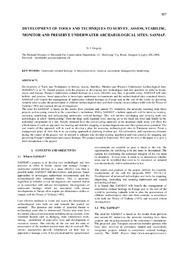| dc.contributor.author | Gregory, D. J. | en |
| dc.date.accessioned | 2013-02-15T08:18:49Z | en |
| dc.date.available | 2013-02-15T08:18:49Z | en |
| dc.date.issued | 2012-10-29 | en |
| dc.identifier.issn | 2047-4970 (Print) | en |
| dc.identifier.uri | http://hdl.handle.net/10797/6123 | en |
| dc.description.abstract | Development of Tools and Techniques to Survey, Assess, Stabilise, Monitor and Preserve Underwater Archaeological Sites (SASMAP) is an EC funded project, with the purpose of developing new technologies and best practices in order to locate, assess and manage Europe's underwater cultural heritage in a more effective way than is possible today. SASMAP will take holistic- and process-based approaches to investigate underwater environments and the archaeological sites contained therein. SASMAP will benefit the management of underwater cultural heritage in Europe and in the rest of the world by providing valuable tools to plan the preservation of offshore archaeological sites and their contents in accordance with both the Treaty of Valletta (1992) and research driven investigations. The need for SASMAP is based on the results from previous and current EU initiatives, the networks resulting from these projects and on-going research at the consortium's institutions. Within SASMAP a holistic approach will be taken to locating, assessing, monitoring and safeguarding underwater cultural heritage. This will involve developing and utilising tools and technologies to allow "down-scaling" from the large scale regional level, moving on to the local site level and finally to the individual components of a site. Results obtained from the down-scaling approach at the proposed study areas will show the effectiveness of such an approach for locating and detailed mapping of archaeological sites and their preservation potential. The end results of this approach will be used to develop a plan for assessing archaeological sites in European waters. From a management point of view this is an up-scaling approach to planning (bottom up). All information and experiences obtained during the course of the project will be utilised to enhance and develop existing legislation and best practice for mapping and preserving Europe's underwater and coastal heritage. The project started in September 2012 and the aim of the paper is to give a brief introduction to the project. | en |
| dc.description.sponsorship | The Conservation Department, The National Museum of Denmark, I. C. Modewegs Vej, Brede, Kongens Lyngby, DK-2800, Denmark. | en |
| dc.language.iso | eng | en |
| dc.publisher | Multi Science Publishing | en |
| dc.relation | info:eu-repo/grantAgreement/EC/FP7/308340 | en |
| dc.relation.ispartof | International Journal of Heritage in the Digital Era, Volume 1, Supplement 1, Pages 367-372 | en |
| dc.rights | info:eu-repo/semantics/openAccess | en |
| dc.subject | Underwater cultural heritage | en |
| dc.subject | In situ preservation | en |
| dc.subject | Location | en |
| dc.subject | Assessment | en |
| dc.subject | Management | en |
| dc.subject | Monitoring | en |
| dc.title | Development of Tools and Techniques to Survey, Assess, Stabilise, Monitor and Preserve Underwater Archaeological Sites: Sasmap | en |
| dc.type | info:eu-repo/semantics/conferenceObject | en |
| dc.identifier.doi | 10.1260/2047-4970.1.0.367 | en |
